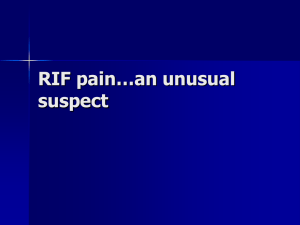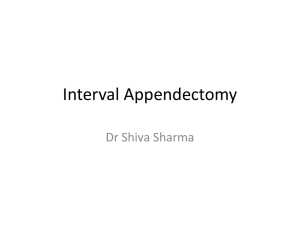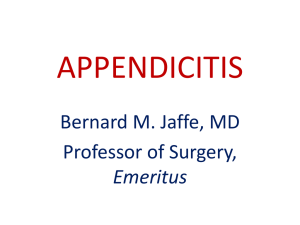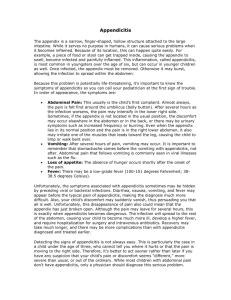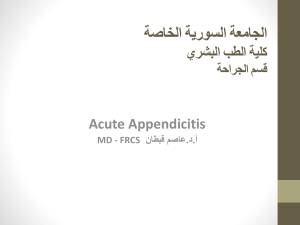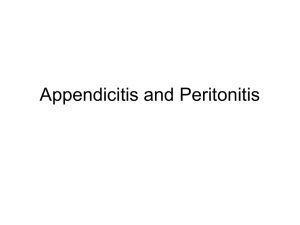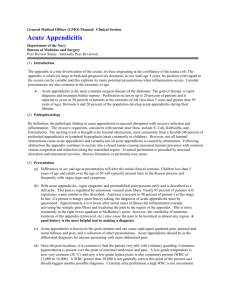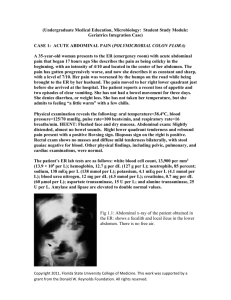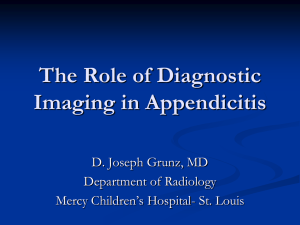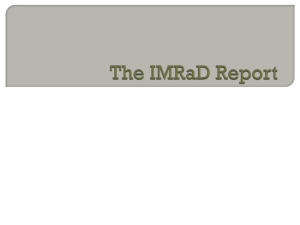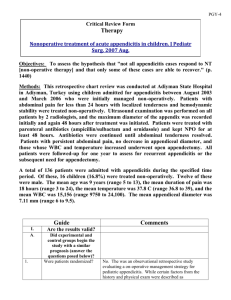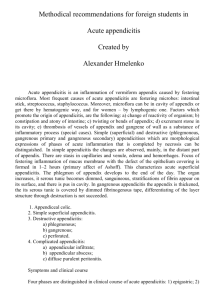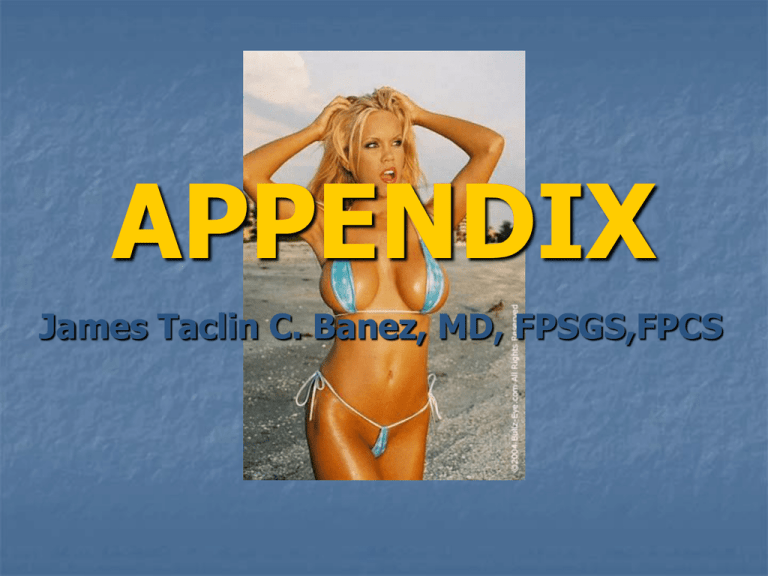
APPENDIX
James Taclin C. Banez, MD, FPSGS,FPCS
Anatomy / Function
Location, position
Function:
Immunologic organ
Secrets IgA,
component of the
GUT associated
lymphoid tissue
(GALT)
Not essential; it’s
removal ----> (-)
sepsis
Appendiceal Conditions of
Surgical Importance
Appendicitis:
Inflammation of the appendix
1500 – perityphlitis – inflammation of the cecal
region
Most common acute surgical disease of the
abdomen
Peak ----> puberty / early adulthood
Male > female (1.3 : 1)
Appendicitis
Pathogenesis:
Obstruction (dominant causal factor)
1.
2.
3.
4.
5.
6.
Fecalith – usual cause
Hypertrophy of the lymphoid tissue
Inspissated barium
Vegetable and fruit seeds
Intestinal worms (Ascaris)
Tumor
Appendicitis
Pathogenesis:
Sequence of events in Luminal Obstruction
Proximal occlusion ---> Closed loop Obst. ---- --> rapid distention due to:
a.
b.
Continuing secretion of the mucosa
Rapid multiplication of normal flora
---> elevate pressure ---> capillary/venous
occlusion (CONGESTION 1st stage):
S/Sx: (+) visceral afferent pain fibers (vague, dull,
diffuse pain in mid-abdomen or lower epigastrium.
Increase peristalsis (crampy pain); N/V and anorexia
Appendicitis
Pathogenesis
Inflammatory process involves the serosa of
appendix and in turns parietal peritoneum in the
region.
Infiltration of PMN (SUPPURATIVE 2nd stage)
Damage of the lining epithelium ---> entrance of
bacteria to the wall.
Impairment of blood supply (inc. pressure than
arterial pressure)---> ellipsoidal infarct at
antimesenteric border near the tip.
(GANGRENOUS 3rd stage) ---> (PERFORATION 4th
stage)
This process is not inevitable. Some subside spontaneously
Appendicitis
Pathogens:
Anaerobes, aerobes
Bacteroides fragilis, Escherichia
coli, Peptostreptococcus,
Pseudomonas, Bacteroides
splanchnicus, Lactobacillus
Appendicitis
Clinical Manifestation:
1.
Abdominal pain:
2.
3.
4.
Classic pain sequence ……….
Right lower quadrant pain
Others:
Left lower quadrant pain (long appendix)
Flank or back pain (retro-cecal)
Supra-pubic (pelvic)
Testicular pain (retro-ileal ----> irritates the spermatic
artery and ureter
Anorexia: nearly always present
Vomiting 75%
Obstipation / diarrhea
Usual sequence (95%) : ANOREXIA ---> ABD. PAIN --> VOMITING
Appendicitis
Signs: PE depends on the location of the
appendix and presence of rupture
1. Direct and rebound tenderness at Mc Burney’s
point. ROVSING sign ---> indicate muscles
peritoneal irritation.
2. Involuntary muscle guarding (true reflex
rigidity).
3. Psoas / Obturator signs ---> retrocecal
appendix
4. Para-rectal tenderness
Stages I & II – uncomplicated
Stages III & IV – complicated
Appendicitis
Laboratory Findings:
1.
2.
WBC: leucocytosis
simple = 10,000 to 18,000/mm3
perforated = >18,000/mm3
Urinalysis :
3.
Hematuria and pyuria due to irritation of the
ureter and urinary bladder
w/o bacteriuria
FPA: rarely helpful; (+) fecalith – rare,
highly suggestive of the dx.
Appendicitis
Graded Compression
sonogram:
4.
78–96% sensitivity; 85–
98% specificity
(+) non-compressible
appendix, 6mm or > at
AP view
(-) easily compressible
5mm; not visualized a &
(-) pericecal fluid or
mass
False (-):
a.
Appendicitis confined
at the tip
b.
Retrocecal position
c.
Perforated appendix
False (+):
a. Periappendicitis from
surrounding inflammation
b. Dilated fallopian tube
c.
Inspissated stool can mimic
an appendicitis
d. Obese pt., appendix not
compressed
Appendicitis
5.
CT scan:
Shd. not delay or
substitute for prompt
operative intervention
when clinically
indicated
Used primarily for
percutaneous
drainage
Appendicitis
6.
Laparoscopy
Diagnostic
/therapeutic
Useful for female to
diferrentiate
gynecological
pathology
Appendiceal Rupture:
Increase morbidity / mortality
No accurate way to determine the occurrence of
rupture
Suspected:
1. Fever > 39 C
2. WBC of > 18,000/mm3
3. Localized rebound, involuntary muscle guarding
4. Signs of genralized peritonitis
5. Ill defined mass (PHLEGMON – motted loops of
bowel adherent to the inflamed appendix)
Differential Diagnosis:
Most common erroneous pre-op diagnosis:
Acute mesenteric lymphaditis
No organic pathologic condition
Acute pelvic pathologic condition
Twisted ovarian cyst / ruptured graafian follicle
Acute gastroenteritis
Acute mesenteric adenitis:
1.
w/ present or recent URTI
Diffuse pain, tenderness not sharp, (-) rigidity
Self limited -----> observe
Differential Diagnosis:
Acute gastroenteritis:
2.
Childhood, viral gastroenteritis
Chills, fever, profuse watery diarrhea, N/V
Hyper-peristaltic abdominal cramps w/o localizing sign
Disease of the male:
3.
Torsion of the testes and acute epididymitis
Diagnosed by palpating the enlarged tender seminal
vesicle
Meckel’s diverticulitis:
4.
Same clinical picture w/ AP
Associated w/ same complication of AP, hence needs
prompt surgical intervention.
Differential Diagnosis:
Intussusceptions:
5.
Shd. Be differentiated pre-operatively due to
different management.
Char:
a. Common under 2 y/o
b. Occur in well nourished infant who suddenly
doubled up due to colicky pain. Hrs. later pass
out bloody mucoid stool
c.
Sausage shape mass in the RLQ
Regional enteritis (Crohn’s dse):
6.
s/sx is almost the same w/ AP this is dx. in
celiotomy
Differential Diagnosis:
UTI / Ureteral stone:
7.
Referred pain to the labia, scroyum or penis
Chills, fever (+) R costo-vertebral angle tenderness,
hematuria, leucocytosis
Dx: -----> pyelography
Gynecological disorders:
8.
Rate of erroneous diagnosis of AP is highest in
young adult female
Order of frequency:
PID -----> ruptured grafian follicle ----> twistd ovarian
cyst or tumor -----> endometriosis -----> ruptured
ectopic pregnancy
TREATMENT
Adequate hydration, correct electrolyte
imbalance
Manage other medical problems
Pre-operative antibiotics:
Simple AP - hrs antibiotic
Ruptured AP - antibiotic until fever
Peritonitis - 10 days antibiotics
Surgery:
1.
Open appendectomy:
McBurney (oblique); Rocky Davis (transverse);
right paramedian; midline incision
Open Appendectomy:
TREATMENT
2.
Laparoscopy:
TREATMENT
Phlegmon and small abscesses can be treated
conservatively w/ IV antibiotic
Well localized abscess ---> percutaneous
drainage
Complex abscess ---> surgical drainage
Interval appendectomy – 6 wks. Following an
acute event treated either non-operatively or
w/ simple drainage of an abscess.
0-37% recurrent appendicitis
PROGNOSIS
Mortality:
9.9% -------> 0.2%
Factors:
1. Ruptured prior to surgery
2.
Age of pt.:
Simple - 0.06%
Ruptured - 3%
Ruptured - 15%
Death due to:
1.
2.
3.
4.
Uncontrolled sepsis (peritonitis, intra-abdominal
abscess, gm (-) septicemia.
Cardiac / pulmonary insufficiency (elderly)
Pulmonary embolism
aspiration
PROGNOSIS
Morbidity:
Simple - 3%
Early:
1.
2.
3.
4.
Ruptured - 47%
Septic :
a. Wound infection / abscess
b. Intra-abdominal abscess (appendiceal fossa,
pouch of Douglas, sub-hepatic space, multiple
intestinal loops.
Fecal fistula:
Wound dehiscence
Intestinal obstruction: due to locculated abscess
& exuberant adhesive formation
PROGNOSIS
Morbidity:
Late:
1.
2.
3.
Adhesived bands
Inguinal hernia (3x greater in pt. who had
appendectomy)
Incisional hernia (paramedian / midline incision)
Appendicitis in the Young
Difficult to establish diagnosis:
1.
2.
Inability of a child to give accurate history
Diagnostic delays by both parents & physicians
Rapid progression to rupture:
Underdeveloped greater omentum ----> higher
morbidity
< 8y/o had a twofold increase rate of perforation
as compared to older children
Appendicitis during Pregnancy
AP is the most frequent extra-uterine dse.
requiring surgical Tx during pregnancy
Most frequent during the 1st & 2nd trimesters
S/Sx:
Abdominal pain, tenderness
Rebound tenderness and guarding less due to
laxity of abdominal wall
Increase WBC; abdominal ultrasound
Dx is difficult due to displacement of the
appendix
Appendicitis during Pregnancy
Dx is difficult due to displacement of the
appendix
Appendicitis during Pregnancy
Risk of surgery:
Premature labor - 10-15% both for negative
laparotomy and appendectomy for uncomplicated AP
Appendiceal perforation is significant factor
associated w/ fetal and maternal death.
Fetal mortality - 3-5% w/ early appendicitis
20% perforation
Suspicion of appendicitis during pregnancy shd
prompt rapid diagnosis and surgical
intervention
Tumors of the Appendix
Appendiceal malignancy is rare
Discovered during laparotomy or in association
w/ acute inflammation of the appendix
1.
CARCINOID:
Firm, yellow, bulbar mass in the appendix
Located: appendix ---> small bowel ----> rectum
Carcinoid syndrome is rare in appendiceal carcinoid
unless widespread metastases are present
Malignant potential related to it’s SIZE ---> > 2cm
Treatment: < 2cm appendectomy
> 2cm right hemicolectomy
Tumors of the Appendix
ADENOCARCINOMA:
2.
Rare
Histologic type:
a. Mucinous adenocarcinoma
b. Colonic adenocarcinoma
c.
Adenocarcinoid
Manifestation:
a. Acute appendicitis
b. RLQ mass
Treatment: right hemicolectomy
Prognosis:
55% ----> 5yr. survival
Tumors of the Appendix
MUCOCELE:
3.
Progressive enlargement of the appendix from the
intraluminal accumulation of a mucoid substance
Histologic type:
a. Retention cyst
b. Mucosal hyperplasia
c.
Cystadenomas
d. Cystadenocarcinoma
Rarely occurs w/ gelatinous ascites (Pseudomyxoma
Peritonei) usually associated w/ malignant ovarian
or appendiceal mucinous CA. if present survival is
decreased
Tumors of the Appendix
MUCOCELE:
3.
Treatment:
Benign - appendectomy
Malignant - right hemicolectomy for
cystadenoCA of the appendix; THABSO and
appendectomy for ovarian cystadenoCA
Adjuvant Tx:
Radiation, intraperitoneal and systemic
chemotherapy recommended but it’s role is
unclear
57% local recurrence at appendiceal primary
site
Death ensues due to progresive obstruction
and renal failure
THANK YOU

